简介
如果 Redis 每执行一条写操作命令,就把该命令以追加的方式写入到一个文件里,然后重启 Redis 的时候,先去读取这个文件里的命令,并且执行它,这不就相当于恢复了缓存数据了吗?
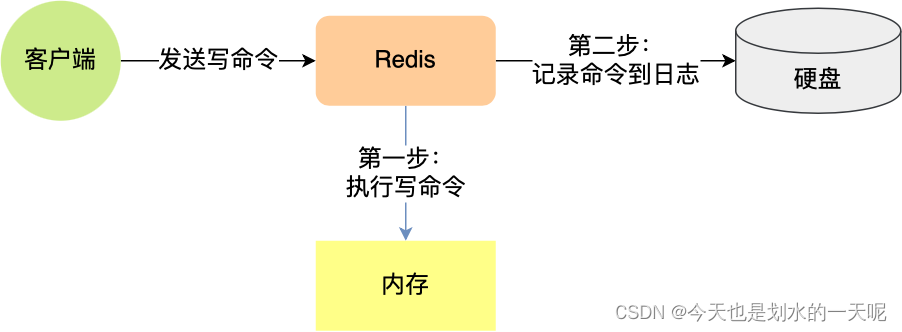
这种保存写操作命令到日志的持久化方式,就是 Redis 里的 AOF(Append Only File) 持久化功能,注意只会记录写操作命令,读操作命令是不会被记录的,因为没意义。
在 Redis 中 AOF 持久化功能默认是不开启的,需要我们修改 redis.conf 配置文件中的以下参数:

AOF 日志文件其实就是普通的文本,我们可以通过 cat 命令查看里面的内容,不过里面的内容如果不知道一定的规则的话,可能会看不懂。
我这里以「set name xiaolin」命令作为例子,Redis 执行了这条命令后,记录在 AOF 日志里的内容如下图:

我这里给大家解释下。
「*3」表示当前命令有三个部分,每部分都是以「$+数字」开头,后面紧跟着具体的命令、键或值。然后,这里的「数字」表示这部分中的命令、键或值一共有多少字节。例如,「$3 set」表示这部分有 3 个字节,也就是「set」命令这个字符串的长度。
不知道大家注意到没有,Redis 是先执行写操作命令后,才将该命令记录到 AOF 日志里的,这么做其实有两个好处。
第一个好处,避免额外的检查开销。
因为如果先将写操作命令记录到 AOF 日志里,再执行该命令的话,如果当前的命令语法有问题,那么如果不进行命令语法检查,该错误的命令记录到 AOF 日志里后,Redis 在使用日志恢复数据时,就可能会出错。
而如果先执行写操作命令再记录日志的话,只有在该命令执行成功后,才将命令记录到 AOF 日志里,这样就不用额外的检查开销,保证记录在 AOF 日志里的命令都是可执行并且正确的。
第二个好处,不会阻塞当前写操作命令的执行,因为当写操作命令执行成功后,才会将命令记录到 AOF 日志。
当然,AOF 持久化功能也不是没有潜在风险。
第一个风险,执行写操作命令和记录日志是两个过程,那当 Redis 在还没来得及将命令写入到硬盘时,服务器发生宕机了,这个数据就会有丢失的风险。
第二个风险,前面说道,由于写操作命令执行成功后才记录到 AOF 日志,所以不会阻塞当前写操作命令的执行,但是可能会给「下一个」命令带来阻塞风险。
因为将命令写入到日志的这个操作也是在主进程完成的(执行命令也是在主进程),也就是说这两个操作是同步的。
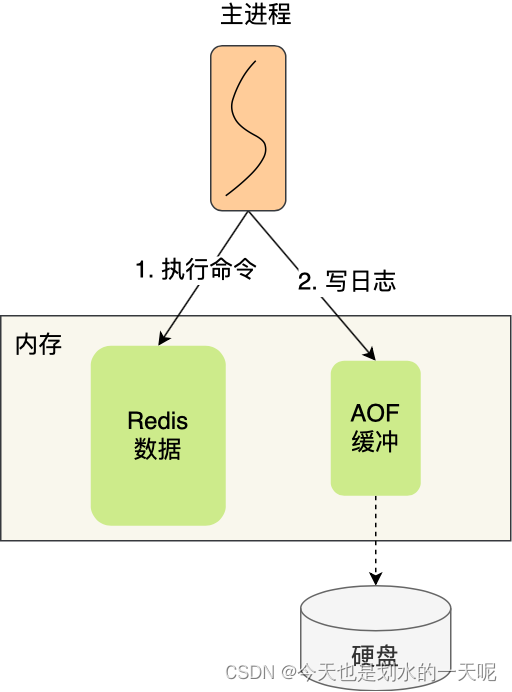
如果在将日志内容写入到硬盘时,服务器的硬盘的 I/O 压力太大,就会导致写硬盘的速度很慢,进而阻塞住了,也就会导致后续的命令无法执行。
认真分析一下,其实这两个风险都有一个共性,都跟「 AOF 日志写回硬盘的时机」有关。
三种写回策略
Redis 写入 AOF 日志的过程,如下图:
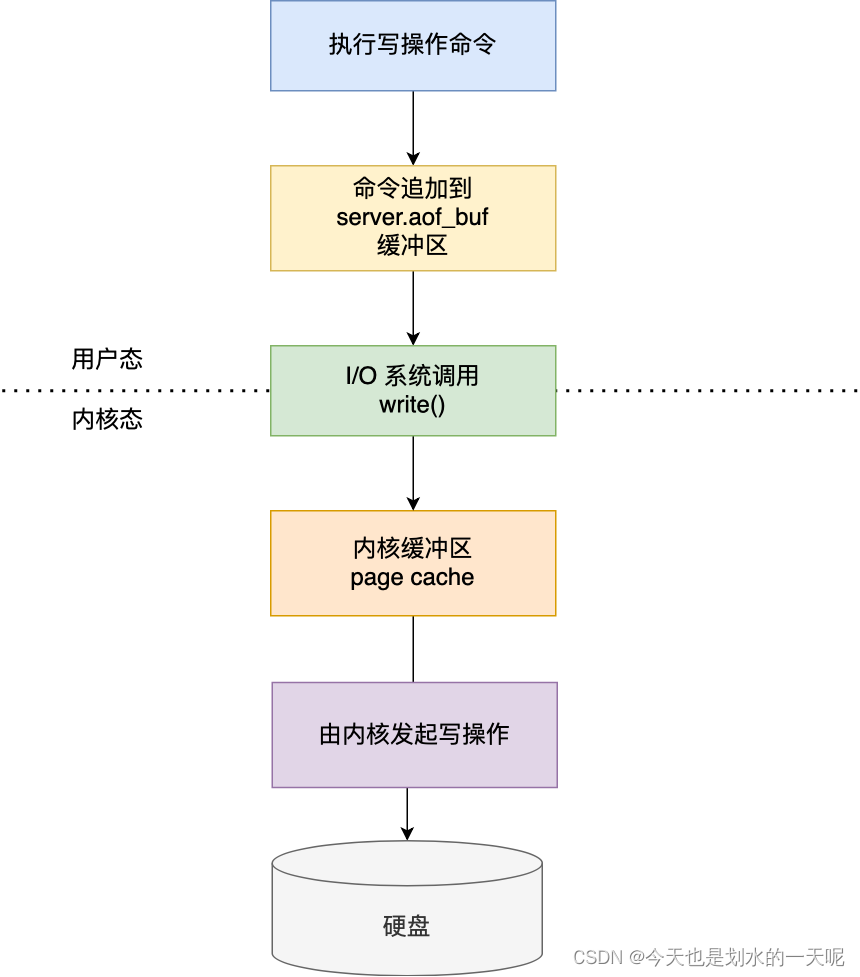
我先来具体说说:
- Redis 执行完写操作命令后,会将命令追加到 server.aof_buf 缓冲区;
- 然后通过 write() 系统调用,将 aof_buf 缓冲区的数据写入到 AOF 文件,此时数据并没有写入到硬盘,而是拷贝到了内核缓冲区 page cache,等待内核将数据写入硬盘;
- 具体内核缓冲区的数据什么时候写入到硬盘,由内核决定。
Redis 提供了 3 种写回硬盘的策略,控制的就是上面说的第三步的过程。
在 redis.conf 配置文件中的 appendfsync 配置项可以有以下 3 种参数可填:
- Always,这个单词的意思是「总是」,所以它的意思是每次写操作命令执行完后,同步将 AOF 日志数据写回硬盘;
- Everysec,这个单词的意思是「每秒」,所以它的意思是每次写操作命令执行完后,先将命令写入到 AOF 文件的内核缓冲区,然后每隔一秒将缓冲区里的内容写回到硬盘;
- No,意味着不由 Redis 控制写回硬盘的时机,转交给操作系统控制写回的时机,也就是每次写操作命令执行完后,先将命令写入到 AOF 文件的内核缓冲区,再由操作系统决定何时将缓冲区内容写回硬盘。
这 3 种写回策略都无法能完美解决「主进程阻塞」和「减少数据丢失」的问题,因为两个问题是对立的,偏向于一边的话,就会要牺牲另外一边,原因如下:
- Always 策略的话,可以最大程度保证数据不丢失,但是由于它每执行一条写操作命令就同步将 AOF 内容写回硬盘,所以是不可避免会影响主进程的性能;
- No 策略的话,是交由操作系统来决定何时将 AOF 日志内容写回硬盘,相比于 Always 策略性能较好,但是操作系统写回硬盘的时机是不可预知的,如果 AOF 日志内容没有写回硬盘,一旦服务器宕机,就会丢失不定数量的数据。
- Everysec 策略的话,是折中的一种方式,避免了 Always 策略的性能开销,也比 No 策略更能避免数据丢失,当然如果上一秒的写操作命令日志没有写回到硬盘,发生了宕机,这一秒内的数据自然也会丢失。
大家根据自己的业务场景进行选择:
- 如果要高性能,就选择 No 策略;
- 如果要高可靠,就选择 Always 策略;
- 如果允许数据丢失一点,但又想性能高,就选择 Everysec 策略。
3 个写回策略的优缺点:
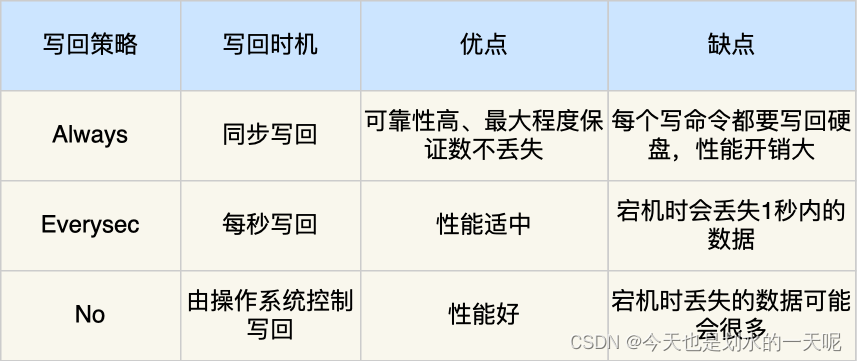
大家知道这三种策略是怎么实现的吗?
深入到源码后,你就会发现这三种策略只是在控制 fsync() 函数的调用时机。
当应用程序向文件写入数据时,内核通常先将数据复制到内核缓冲区中,然后排入队列,然后由内核决定何时写入硬盘。
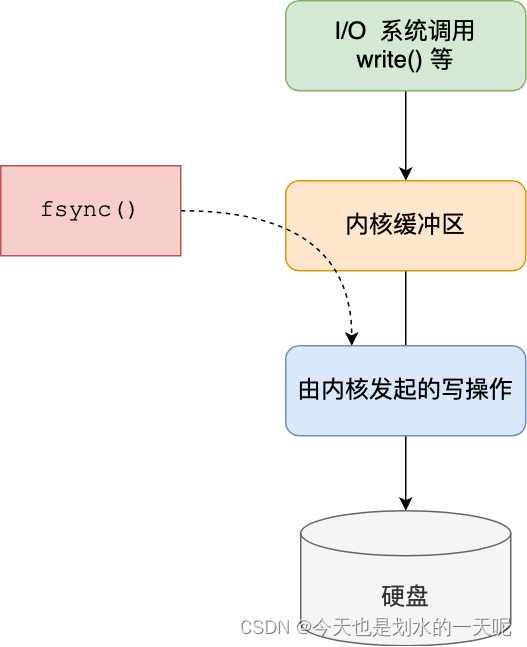
如果想要应用程序向文件写入数据后,能立马将数据同步到硬盘,就可以调用 fsync() 函数,这样内核就会将内核缓冲区的数据直接写入到硬盘,等到硬盘写操作完成后,该函数才会返回。
- Always 策略就是每次写入 AOF 文件数据后,就执行 fsync() 函数;
- Everysec 策略就会创建一个异步任务来执行 fsync() 函数;
- No 策略就是永不执行 fsync() 函数;
AOF 重写机制
AOF 日志是一个文件,随着执行的写操作命令越来越多,文件的大小会越来越大。
如果当 AOF 日志文件过大就会带来性能问题,比如重启 Redis 后,需要读 AOF 文件的内容以恢复数据,如果文件过大,整个恢复的过程就会很慢。
所以,Redis 为了避免 AOF 文件越写越大,提供了 AOF 重写机制,当 AOF 文件的大小超过所设定的阈值后,Redis 就会启用 AOF 重写机制,来压缩 AOF 文件。
AOF 重写机制是在重写时,读取当前数据库中的所有键值对,然后将每一个键值对用一条命令记录到「新的 AOF 文件」,等到全部记录完后,就将新的 AOF 文件替换掉现有的 AOF 文件。
举个例子,在没有使用重写机制前,假设前后执行了「set name xiaolin」和「set name xiaolincoding」这两个命令的话,就会将这两个命令记录到 AOF 文件。

但是在使用重写机制后,就会读取 name 最新的 value(键值对) ,然后用一条 「set name xiaolincoding」命令记录到新的 AOF 文件,之前的第一个命令就没有必要记录了,因为它属于「历史」命令,没有作用了。这样一来,一个键值对在重写日志中只用一条命令就行了。
重写工作完成后,就会将新的 AOF 文件覆盖现有的 AOF 文件,这就相当于压缩了 AOF 文件,使得 AOF 文件体积变小了。
然后,在通过 AOF 日志恢复数据时,只用执行这条命令,就可以直接完成这个键值对的写入了。
所以,重写机制的妙处在于,尽管某个键值对被多条写命令反复修改,最终也只需要根据这个「键值对」当前的最新状态,然后用一条命令去记录键值对,代替之前记录这个键值对的多条命令,这样就减少了 AOF 文件中的命令数量。最后在重写工作完成后,将新的 AOF 文件覆盖现有的 AOF 文件。
这里说一下为什么重写 AOF 的时候,不直接复用现有的 AOF 文件,而是先写到新的 AOF 文件再覆盖过去。
因为如果 AOF 重写过程中失败了,现有的 AOF 文件就会造成污染,可能无法用于恢复使用。
所以 AOF 重写过程,先重写到新的 AOF 文件,重写失败的话,就直接删除这个文件就好,不会对现有的 AOF 文件造成影响。
AOF 后台重写
写入 AOF 日志的操作虽然是在主进程完成的,因为它写入的内容不多,所以一般不太影响命令的操作。
但是在触发 AOF 重写时,比如当 AOF 文件大于 64M 时,就会对 AOF 文件进行重写,这时是需要读取所有缓存的键值对数据,并为每个键值对生成一条命令,然后将其写入到新的 AOF 文件,重写完后,就把现在的 AOF 文件替换掉。
这个过程其实是很耗时的,所以重写的操作不能放在主进程里。
所以,Redis 的重写 AOF 过程是由后台子进程 bgrewriteaof 来完成的,这么做可以达到两个好处:
- 子进程进行 AOF 重写期间,主进程可以继续处理命令请求,从而避免阻塞主进程;
- 子进程带有主进程的数据副本(数据副本怎么产生的后面会说),这里使用子进程而不是线程,因为如果是使用线程,多线程之间会共享内存,那么在修改共享内存数据的时候,需要通过加锁来保证数据的安全,而这样就会降低性能。而使用子进程,创建子进程时,父子进程是共享内存数据的,不过这个共享的内存只能以只读的方式,而当父子进程任意一方修改了该共享内存,就会发生「写时复制」,于是父子进程就有了独立的数据副本,就不用加锁来保证数据安全。
子进程是怎么拥有主进程一样的数据副本的呢?
主进程在通过 fork 系统调用生成 bgrewriteaof 子进程时,操作系统会把主进程的「页表」复制一份给子进程,这个页表记录着虚拟地址和物理地址映射关系,而不会复制物理内存,也就是说,两者的虚拟空间不同,但其对应的物理空间是同一个。
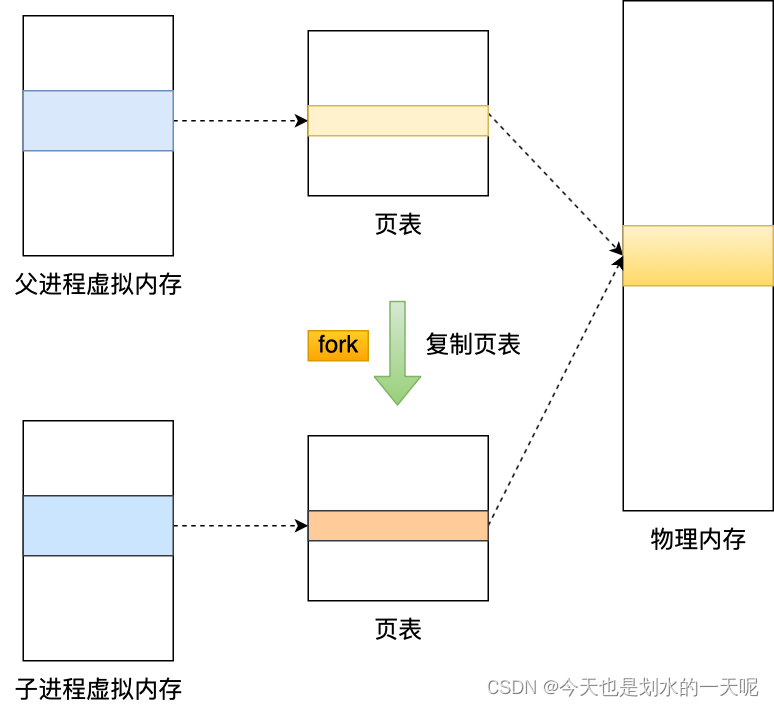
这样一来,子进程就共享了父进程的物理内存数据了,这样能够节约物理内存资源,页表对应的页表项的属性会标记该物理内存的权限为只读。
不过,当父进程或者子进程在向这个内存发起写操作时,CPU 就会触发写保护中断,这个写保护中断是由于违反权限导致的,然后操作系统会在「写保护中断处理函数」里进行物理内存的复制,并重新设置其内存映射关系,将父子进程的内存读写权限设置为可读写,最后才会对内存进行写操作,这个过程被称为「写时复制(Copy On Write)」。
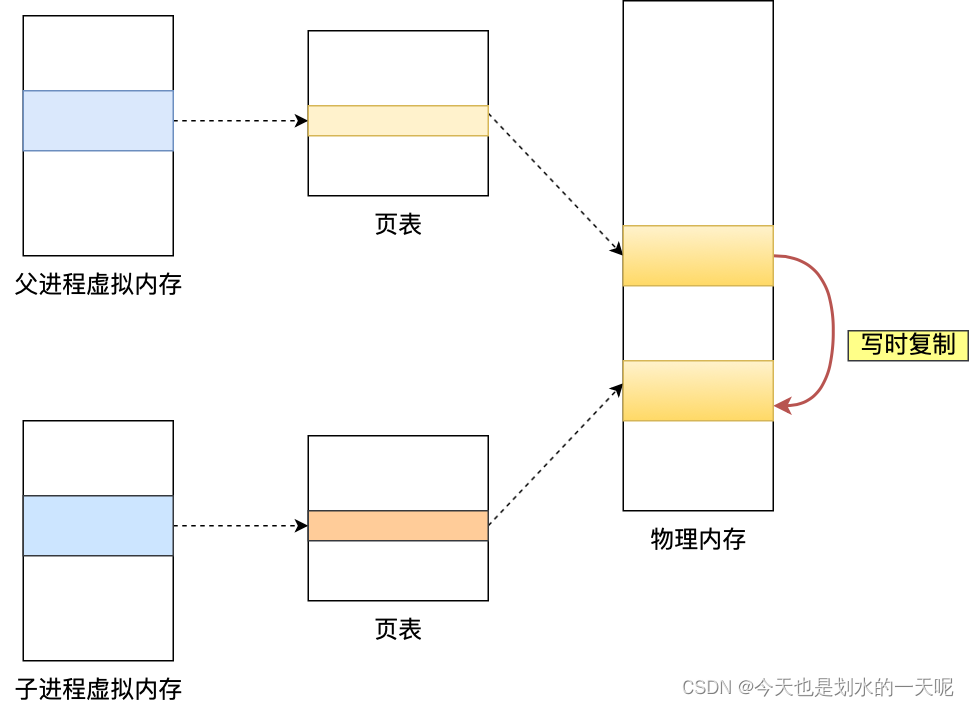
写时复制顾名思义,在发生写操作的时候,操作系统才会去复制物理内存,这样是为了防止 fork 创建子进程时,由于物理内存数据的复制时间过长而导致父进程长时间阻塞的问题。
当然,操作系统复制父进程页表的时候,父进程也是阻塞中的,不过页表的大小相比实际的物理内存小很多,所以通常复制页表的过程是比较快的。
不过,如果父进程的内存数据非常大,那自然页表也会很大,这时父进程在通过 fork 创建子进程的时候,阻塞的时间也越久。
所以,有两个阶段会导致阻塞父进程:
- 创建子进程的途中,由于要复制父进程的页表等数据结构,阻塞的时间跟页表的大小有关,页表越大,阻塞的时间也越长;
- 创建完子进程后,如果子进程或者父进程修改了共享数据,就会发生写时复制,这期间会拷贝物理内存,如果内存越大,自然阻塞的时间也越长;
触发重写机制后,主进程就会创建重写 AOF 的子进程,此时父子进程共享物理内存,重写子进程只会对这个内存进行只读,重写 AOF 子进程会读取数据库里的所有数据,并逐一把内存数据的键值对转换成一条命令,再将命令记录到重写日志(新的 AOF 文件)。
但是子进程重写过程中,主进程依然可以正常处理命令。
如果此时主进程修改了已经存在 key-value,就会发生写时复制,注意这里只会复制主进程修改的物理内存数据,没修改物理内存还是与子进程共享的。
所以如果这个阶段修改的是一个 bigkey,也就是数据量比较大的 key-value 的时候,这时复制的物理内存数据的过程就会比较耗时,有阻塞主进程的风险。
还有个问题,重写 AOF 日志过程中,如果主进程修改了已经存在 key-value,此时这个 key-value 数据在子进程的内存数据就跟主进程的内存数据不一致了,这时要怎么办呢?
为了解决这种数据不一致问题,Redis 设置了一个 AOF 重写缓冲区,这个缓冲区在创建 bgrewriteaof 子进程之后开始使用。
在重写 AOF 期间,当 Redis 执行完一个写命令之后,它会同时将这个写命令写入到 「AOF 缓冲区」和 「AOF 重写缓冲区」。
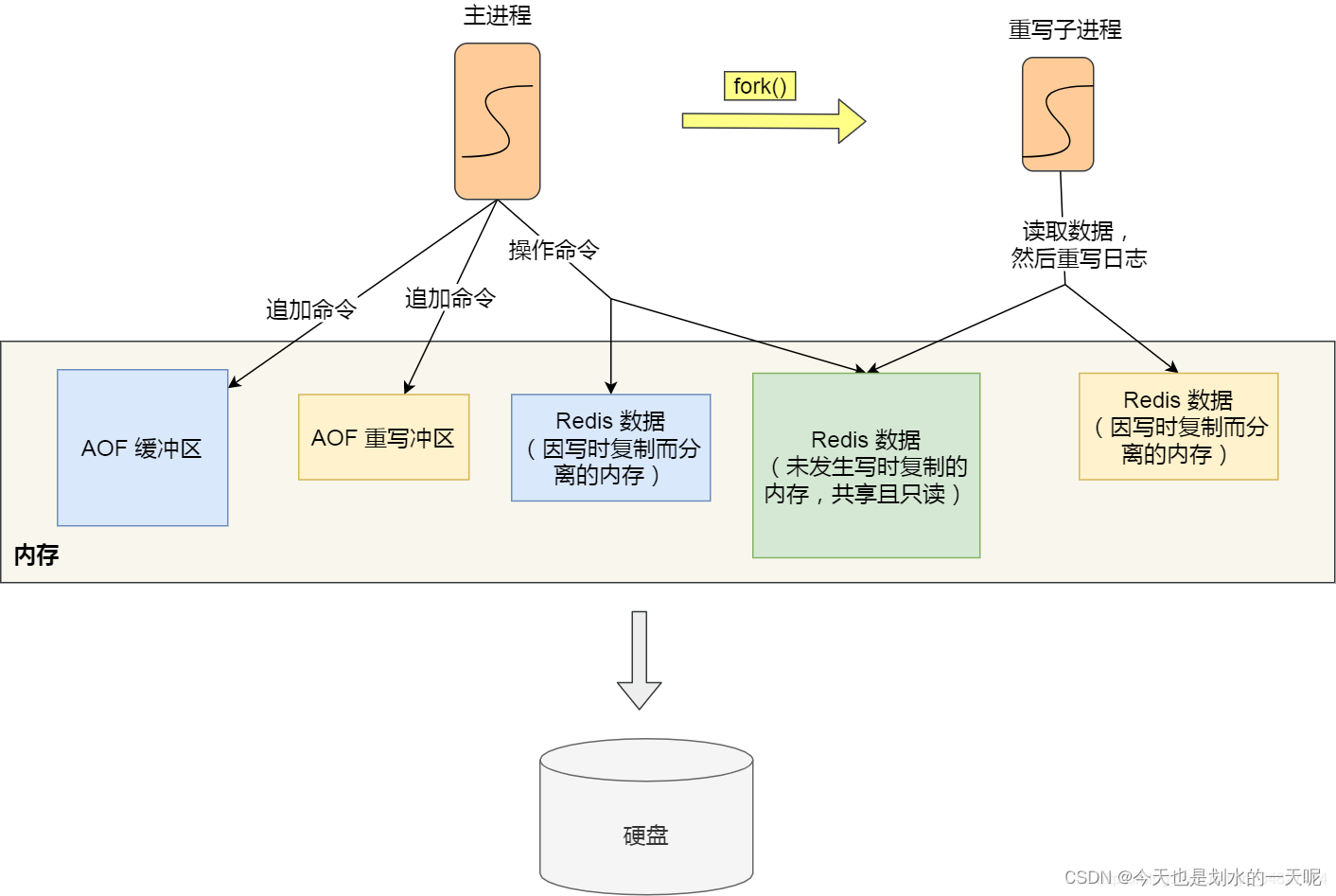
也就是说,在 bgrewriteaof 子进程执行 AOF 重写期间,主进程需要执行以下三个工作:
- 执行客户端发来的命令;
- 将执行后的写命令追加到 「AOF 缓冲区」;
- 将执行后的写命令追加到 「AOF 重写缓冲区」;
当子进程完成 AOF 重写工作(扫描数据库中所有数据,逐一把内存数据的键值对转换成一条命令,再将命令记录到重写日志)后,会向主进程发送一条信号,信号是进程间通讯的一种方式,且是异步的。
主进程收到该信号后,会调用一个信号处理函数,该函数主要做以下工作:
将 AOF 重写缓冲区中的所有内容追加到新的 AOF 的文件中,使得新旧两个 AOF 文件所保存的数据库状态一致;
新的 AOF 的文件进行改名,覆盖现有的 AOF 文件。
信号函数执行完后,主进程就可以继续像往常一样处理命令了。
在整个 AOF 后台重写过程中,除了发生写时复制会对主进程造成阻塞,还有信号处理函数执行时也会对主进程造成阻塞,在其他时候,AOF 后台重写都不会阻塞主进程。
aof执行流程
AOF的策略保证了我们能够在断电的情况下不丢失超过一秒的数据(极端情况两秒,下面会说),分为三种策略,这里不详细讨论.我们只说它们的区别,就是多长时间进行一次fsync,即把数据从内核缓冲刷入磁盘.因为如果数据已经写入磁盘,我们就可以认为数据已经持久化了,所以fsync的间隔是保证redis数据安全的最重要的要素.
下面说下为什么会丢失超过两秒的数据,可以参考flushAppendOnlyFile中的代码解析.因为fsync这个操作可能执行时间比较长,如果在下一次执行flush的时候上一次fsync还未完成且此次flush距上次间隔在两秒之内的话,此次flush的不会执行,会直接退出,这些数据就会只存在在内存中,这样就会导致在有些情况下两秒的数据丢失.
首先列出在我们执行AOF时redisserver中我们需要使用的参数:
struct rediserver{
// AOF 文件的当前字节大小
off_t aof_current_size; /* AOF current size. */
int aof_rewrite_scheduled; /* Rewrite once BGSAVE terminates. */
// 负责进行 AOF 重写的子进程 ID
pid_t aof_child_pid; /* PID if rewriting process */
// AOF 重写缓存链表,链接着多个缓存块 用于在AOF执行时缓存到来的命令
list *aof_rewrite_buf_blocks; /* Hold changes during an AOF rewrite. */
// AOF 缓冲区
sds aof_buf; /* AOF buffer, written before entering the event loop */
// AOF 文件的描述符
int aof_fd; /* File descriptor of currently selected AOF file */
// AOF 的当前目标数据库
int aof_selected_db; /* Currently selected DB in AOF */
.......
// 推迟 write 操作的时间
time_t aof_flush_postponed_start; /* UNIX time of postponed AOF flush */
// 最后一直执行 fsync 的时间
time_t aof_last_fsync; /* UNIX time of last fsync() */
time_t aof_rewrite_time_last; /* Time used by last AOF rewrite run. */
// AOF 重写的开始时间
time_t aof_rewrite_time_start; /* Current AOF rewrite start time. */
..........
}
首先是在每次事件循环结束时要执行的flush操作flushAppendOnlyFile,它的作用是把我们写入在aof_buf中的缓冲数据通过write写入系统缓冲区,然后通过系统中的配置appendfsync来决定fsync的频率.上面已经提到了.接下来我们就来看看源码吧
事件循环中的flush操作
/* Write the append only file buffer on disk.
*
* 将 AOF 缓存写入到文件中。
*
* Since we are required to write the AOF before replying to the client,
* and the only way the client socket can get a write is entering when the
* the event loop, we accumulate all the AOF writes in a memory
* buffer and write it on disk using this function just before entering
* the event loop again.
*
* 因为程序需要在回复客户端之前对 AOF 执行写操作。
* 而客户端能执行写操作的唯一机会就是在事件 loop 中,
* 因此,程序将所有 AOF 写累积到缓存中,
* 并在重新进入事件 loop 之前,将缓存写入到文件中。
*
* About the 'force' argument:
*
* 关于 force 参数:
*
* When the fsync policy is set to 'everysec' we may delay the flush if there
* is still an fsync() going on in the background thread, since for instance
* on Linux write(2) will be blocked by the background fsync anyway.
*
* 当 fsync 策略为每秒钟保存一次时,如果后台线程仍然有 fsync 在执行,
* 那么我们可能会延迟执行冲洗(flush)操作,
* 因为 Linux 上的 write(2) 会被后台的 fsync 阻塞。
*
* When this happens we remember that there is some aof buffer to be
* flushed ASAP, and will try to do that in the serverCron() function.
*
* 当这种情况发生时,说明需要尽快冲洗 aof 缓存,
* 程序会尝试在 serverCron() 函数中对缓存进行冲洗。
*
* However if force is set to 1 we'll write regardless of the background
* fsync.
*
* 不过,如果 force 为 1 的话,那么不管后台是否正在 fsync ,
* 程序都直接进行写入。
*/
#define AOF_WRITE_LOG_ERROR_RATE 30 /* Seconds between errors logging. */
void flushAppendOnlyFile(int force) {
ssize_t nwritten;
int sync_in_progress = 0;
// 缓冲区中没有任何内容,直接返回
if (sdslen(server.aof_buf) == 0) return;
// 策略为每秒 FSYNC
if (server.aof_fsync == AOF_FSYNC_EVERYSEC)
// 是否有 SYNC 正在后台进行?
sync_in_progress = bioPendingJobsOfType(REDIS_BIO_AOF_FSYNC) != 0;
// 每秒 fsync ,并且强制写入为假
if (server.aof_fsync == AOF_FSYNC_EVERYSEC && !force) {
/* With this append fsync policy we do background fsyncing.
*
* 当 fsync 策略为每秒钟一次时, fsync 在后台执行。
*
* If the fsync is still in progress we can try to delay
* the write for a couple of seconds.
*
* 如果后台仍在执行 FSYNC ,那么我们可以延迟写操作一两秒
* (如果强制执行 write 的话,服务器主线程将阻塞在 write 上面)
*/
if (sync_in_progress) {
// 有 fsync 正在后台进行 。。。
if (server.aof_flush_postponed_start == 0) {
/* No previous write postponinig, remember that we are
* postponing the flush and return.
*
* 前面没有推迟过 write 操作,这里将推迟写操作的时间记录下来
* 然后就返回,不执行 write 或者 fsync
*/
server.aof_flush_postponed_start = server.unixtime;
return;
} else if (server.unixtime - server.aof_flush_postponed_start < 2) {
/* We were already waiting for fsync to finish, but for less
* than two seconds this is still ok. Postpone again.
*
* 如果之前已经因为 fsync 而推迟了 write 操作
* 但是推迟的时间不超过 2 秒,那么直接返回
* 不执行 write 或者 fsync
*/
return;
}
/* Otherwise fall trough, and go write since we can't wait
* over two seconds.
*
* 如果后台还有 fsync 在执行,并且 write 已经推迟 >= 2 秒
* 那么执行写操作(write 将被阻塞)
*/
server.aof_delayed_fsync++;
redisLog(REDIS_NOTICE,"Asynchronous AOF fsync is taking too long (disk is busy?). Writing the AOF buffer without waiting for fsync to complete, this may slow down Redis.");
}
}
/* If you are following this code path, then we are going to write so
* set reset the postponed flush sentinel to zero.
*
* 执行到这里,程序会对 AOF 文件进行写入。
*
* 清零延迟 write 的时间记录
*/
server.aof_flush_postponed_start = 0;
/* We want to perform a single write. This should be guaranteed atomic
* at least if the filesystem we are writing is a real physical one.
*
* 执行单个 write 操作,如果写入设备是物理的话,那么这个操作应该是原子的
*
* While this will save us against the server being killed I don't think
* there is much to do about the whole server stopping for power problems
* or alike
*
* 当然,如果出现像电源中断这样的不可抗现象,那么 AOF 文件也是可能会出现问题的
* 这时就要用 redis-check-aof 程序来进行修复。
*/
nwritten = write(server.aof_fd,server.aof_buf,sdslen(server.aof_buf));
if (nwritten != (signed)sdslen(server.aof_buf)) {
static time_t last_write_error_log = 0;
int can_log = 0;
/* Limit logging rate to 1 line per AOF_WRITE_LOG_ERROR_RATE seconds. */
// 将日志的记录频率限制在每行 AOF_WRITE_LOG_ERROR_RATE 秒
if ((server.unixtime - last_write_error_log) > AOF_WRITE_LOG_ERROR_RATE) {
can_log = 1;
last_write_error_log = server.unixtime;
}
/* Lof the AOF write error and record the error code. */
// 如果写入出错,那么尝试将该情况写入到日志里面
if (nwritten == -1) {
if (can_log) {
redisLog(REDIS_WARNING,"Error writing to the AOF file: %s",
strerror(errno));
server.aof_last_write_errno = errno;
}
} else {
if (can_log) {
redisLog(REDIS_WARNING,"Short write while writing to "
"the AOF file: (nwritten=%lld, "
"expected=%lld)",
(long long)nwritten,
(long long)sdslen(server.aof_buf));
}
// 尝试移除新追加的不完整内容
if (ftruncate(server.aof_fd, server.aof_current_size) == -1) {
if (can_log) {
redisLog(REDIS_WARNING, "Could not remove short write "
"from the append-only file. Redis may refuse "
"to load the AOF the next time it starts. "
"ftruncate: %s", strerror(errno));
}
} else {
/* If the ftrunacate() succeeded we can set nwritten to
* -1 since there is no longer partial data into the AOF. */
nwritten = -1;
}
server.aof_last_write_errno = ENOSPC;
}
/* Handle the AOF write error. */
// 处理写入 AOF 文件时出现的错误
if (server.aof_fsync == AOF_FSYNC_ALWAYS) {
/* We can't recover when the fsync policy is ALWAYS since the
* reply for the client is already in the output buffers, and we
* have the contract with the user that on acknowledged write data
* is synched on disk. */
redisLog(REDIS_WARNING,"Can't recover from AOF write error when the AOF fsync policy is 'always'. Exiting...");
exit(1);
} else {
/* Recover from failed write leaving data into the buffer. However
* set an error to stop accepting writes as long as the error
* condition is not cleared. */
server.aof_last_write_status = REDIS_ERR;
/* Trim the sds buffer if there was a partial write, and there
* was no way to undo it with ftruncate(2). */
if (nwritten > 0) {
server.aof_current_size += nwritten;
sdsrange(server.aof_buf,nwritten,-1);
}
return; /* We'll try again on the next call... */
}
} else {
/* Successful write(2). If AOF was in error state, restore the
* OK state and log the event. */
// 写入成功,更新最后写入状态
if (server.aof_last_write_status == REDIS_ERR) {
redisLog(REDIS_WARNING,
"AOF write error looks solved, Redis can write again.");
server.aof_last_write_status = REDIS_OK;
}
}
// 更新写入后的 AOF 文件大小
server.aof_current_size += nwritten;
/* Re-use AOF buffer when it is small enough. The maximum comes from the
* arena size of 4k minus some overhead (but is otherwise arbitrary).
*
* 如果 AOF 缓存的大小足够小的话,那么重用这个缓存,
* 否则的话,释放 AOF 缓存。
*/
if ((sdslen(server.aof_buf)+sdsavail(server.aof_buf)) < 4000) {
// 清空缓存中的内容,等待重用
sdsclear(server.aof_buf);
} else {
// 释放缓存
sdsfree(server.aof_buf);
server.aof_buf = sdsempty();
}
/* Don't fsync if no-appendfsync-on-rewrite is set to yes and there are
* children doing I/O in the background.
*
* 如果 no-appendfsync-on-rewrite 选项为开启状态,
* 并且有 BGSAVE 或者 BGREWRITEAOF 正在进行的话,
* 那么不执行 fsync
*/
if (server.aof_no_fsync_on_rewrite &&
(server.aof_child_pid != -1 || server.rdb_child_pid != -1))
return;
/* Perform the fsync if needed. */
// 总是执行 fsnyc
if (server.aof_fsync == AOF_FSYNC_ALWAYS) {
/* aof_fsync is defined as fdatasync() for Linux in order to avoid
* flushing metadata. */
aof_fsync(server.aof_fd); /* Let's try to get this data on the disk */
// 更新最后一次执行 fsnyc 的时间
server.aof_last_fsync = server.unixtime;
// 策略为每秒 fsnyc ,并且距离上次 fsync 已经超过 1 秒
} else if ((server.aof_fsync == AOF_FSYNC_EVERYSEC &&
server.unixtime > server.aof_last_fsync)) {
// 放到后台执行
if (!sync_in_progress) aof_background_fsync(server.aof_fd);
// 更新最后一次执行 fsync 的时间
server.aof_last_fsync = server.unixtime;
}
// 其实上面无论执行 if 部分还是 else 部分都要更新 fsync 的时间
// 可以将代码挪到下面来
// server.aof_last_fsync = server.unixtime;
}
重写操作
/* This is how rewriting of the append only file in background works:
*
* 以下是后台重写 AOF 文件(BGREWRITEAOF)的工作步骤:
*
* 1) The user calls BGREWRITEAOF
* 用户调用 BGREWRITEAOF
*
* 2) Redis calls this function, that forks():
* Redis 调用这个函数,它执行 fork() :
*
* 2a) the child rewrite the append only file in a temp file.
* 子进程在临时文件中对 AOF 文件进行重写
*
* 2b) the parent accumulates differences in server.aof_rewrite_buf.
* 父进程将新输入的写命令追加到 server.aof_rewrite_buf 中
*
* 3) When the child finished '2a' exists.
* 当步骤 2a 执行完之后,子进程结束
*
* 4) The parent will trap the exit code, if it's OK, will append the
* data accumulated into server.aof_rewrite_buf into the temp file, and
* finally will rename(2) the temp file in the actual file name.
* The the new file is reopened as the new append only file. Profit!
*
* 父进程会捕捉子进程的退出信号,
* 如果子进程的退出状态是 OK 的话,
* 那么父进程将新输入命令的缓存追加到临时文件,
* 然后使用 rename(2) 对临时文件改名,用它代替旧的 AOF 文件,
* 至此,后台 AOF 重写完成。
*/
int rewriteAppendOnlyFileBackground(void) {
pid_t childpid;
long long start;
// 已经有进程在进行 AOF 重写了
if (server.aof_child_pid != -1) return REDIS_ERR;
// 记录 fork 开始前的时间,计算 fork 耗时用
start = ustime();
if ((childpid = fork()) == 0) {
char tmpfile[256];
/* Child */
// 关闭网络连接 fd
closeListeningSockets(0);
// 为进程设置名字,方便记认
redisSetProcTitle("redis-aof-rewrite");
// 创建临时文件,并进行 AOF 重写
snprintf(tmpfile,256,"temp-rewriteaof-bg-%d.aof", (int) getpid());
if (rewriteAppendOnlyFile(tmpfile) == REDIS_OK) {
size_t private_dirty = zmalloc_get_private_dirty();
if (private_dirty) {
redisLog(REDIS_NOTICE,
"AOF rewrite: %zu MB of memory used by copy-on-write",
private_dirty/(1024*1024));
}
// 发送重写成功信号
exitFromChild(0);
} else {
// 发送重写失败信号
exitFromChild(1);
}
} else {
/* Parent */
// 记录执行 fork 所消耗的时间
server.stat_fork_time = ustime()-start;
if (childpid == -1) {
redisLog(REDIS_WARNING,
"Can't rewrite append only file in background: fork: %s",
strerror(errno));
return REDIS_ERR;
}
redisLog(REDIS_NOTICE,
"Background append only file rewriting started by pid %d",childpid);
// 记录 AOF 重写的信息
server.aof_rewrite_scheduled = 0;
server.aof_rewrite_time_start = time(NULL);
server.aof_child_pid = childpid;
// 关闭字典自动 rehash
updateDictResizePolicy();
/* We set appendseldb to -1 in order to force the next call to the
* feedAppendOnlyFile() to issue a SELECT command, so the differences
* accumulated by the parent into server.aof_rewrite_buf will start
* with a SELECT statement and it will be safe to merge.
*
* 将 aof_selected_db 设为 -1 ,
* 强制让 feedAppendOnlyFile() 下次执行时引发一个 SELECT 命令,
* 从而确保之后新添加的命令会设置到正确的数据库中
*/
server.aof_selected_db = -1;
replicationScriptCacheFlush();
return REDIS_OK;
}
return REDIS_OK; /* unreached */
}
/* Write a sequence of commands able to fully rebuild the dataset into
* "filename". Used both by REWRITEAOF and BGREWRITEAOF.
*
* 将一集足以还原当前数据集的命令写入到 filename 指定的文件中。
*
* 这个函数被 REWRITEAOF 和 BGREWRITEAOF 两个命令调用。
* (REWRITEAOF 似乎已经是一个废弃的命令)
*
* In order to minimize the number of commands needed in the rewritten
* log Redis uses variadic commands when possible, such as RPUSH, SADD
* and ZADD. However at max REDIS_AOF_REWRITE_ITEMS_PER_CMD items per time
* are inserted using a single command.
*
* 为了最小化重建数据集所需执行的命令数量,
* Redis 会尽可能地使用接受可变参数数量的命令,比如 RPUSH 、SADD 和 ZADD 等。
*
* 不过单个命令每次处理的元素数量不能超过 REDIS_AOF_REWRITE_ITEMS_PER_CMD 。
*/
int rewriteAppendOnlyFile(char *filename) {
dictIterator *di = NULL;
dictEntry *de;
rio aof;
FILE *fp;
char tmpfile[256];
int j;
long long now = mstime();
/* Note that we have to use a different temp name here compared to the
* one used by rewriteAppendOnlyFileBackground() function.
*
* 创建临时文件
*
* 注意这里创建的文件名和 rewriteAppendOnlyFileBackground() 创建的文件名稍有不同
*/
snprintf(tmpfile,256,"temp-rewriteaof-%d.aof", (int) getpid());
fp = fopen(tmpfile,"w");
if (!fp) {
redisLog(REDIS_WARNING, "Opening the temp file for AOF rewrite in rewriteAppendOnlyFile(): %s", strerror(errno));
return REDIS_ERR;
}
// 初始化文件 io
rioInitWithFile(&aof,fp);
// 设置每写入 REDIS_AOF_AUTOSYNC_BYTES 字节
// 就执行一次 FSYNC
// 防止缓存中积累太多命令内容,造成 I/O 阻塞时间过长
if (server.aof_rewrite_incremental_fsync)
rioSetAutoSync(&aof,REDIS_AOF_AUTOSYNC_BYTES);
// 遍历所有数据库
for (j = 0; j < server.dbnum; j++) {
char selectcmd[] = "*2\r\n$6\r\nSELECT\r\n";
redisDb *db = server.db+j;
// 指向键空间
dict *d = db->dict;
if (dictSize(d) == 0) continue;
// 创建键空间迭代器
di = dictGetSafeIterator(d);
if (!di) {
fclose(fp);
return REDIS_ERR;
}
/* SELECT the new DB
*
* 首先写入 SELECT 命令,确保之后的数据会被插入到正确的数据库上
*/
if (rioWrite(&aof,selectcmd,sizeof(selectcmd)-1) == 0) goto werr;
if (rioWriteBulkLongLong(&aof,j) == 0) goto werr;
/* Iterate this DB writing every entry
*
* 遍历数据库所有键,并通过命令将它们的当前状态(值)记录到新 AOF 文件中
*/
while((de = dictNext(di)) != NULL) {
sds keystr;
robj key, *o;
long long expiretime;
// 取出键
keystr = dictGetKey(de);
// 取出值
o = dictGetVal(de);
initStaticStringObject(key,keystr);
// 取出过期时间
expiretime = getExpire(db,&key);
/* If this key is already expired skip it
*
* 如果键已经过期,那么跳过它,不保存
*/
if (expiretime != -1 && expiretime < now) continue;
/* Save the key and associated value
*
* 根据值的类型,选择适当的命令来保存值
*/
if (o->type == REDIS_STRING) {
/* Emit a SET command */
char cmd[]="*3\r\n$3\r\nSET\r\n";
if (rioWrite(&aof,cmd,sizeof(cmd)-1) == 0) goto werr;
/* Key and value */
if (rioWriteBulkObject(&aof,&key) == 0) goto werr;
if (rioWriteBulkObject(&aof,o) == 0) goto werr;
} else if (o->type == REDIS_LIST) {
if (rewriteListObject(&aof,&key,o) == 0) goto werr;
} else if (o->type == REDIS_SET) {
if (rewriteSetObject(&aof,&key,o) == 0) goto werr;
} else if (o->type == REDIS_ZSET) {
if (rewriteSortedSetObject(&aof,&key,o) == 0) goto werr;
} else if (o->type == REDIS_HASH) {
if (rewriteHashObject(&aof,&key,o) == 0) goto werr;
} else {
redisPanic("Unknown object type");
}
/* Save the expire time
*
* 保存键的过期时间
*/
if (expiretime != -1) {
char cmd[]="*3\r\n$9\r\nPEXPIREAT\r\n";
// 写入 PEXPIREAT expiretime 命令
if (rioWrite(&aof,cmd,sizeof(cmd)-1) == 0) goto werr;
if (rioWriteBulkObject(&aof,&key) == 0) goto werr;
if (rioWriteBulkLongLong(&aof,expiretime) == 0) goto werr;
}
}
// 释放迭代器
dictReleaseIterator(di);
}
/* Make sure data will not remain on the OS's output buffers */
// 冲洗并关闭新 AOF 文件
if (fflush(fp) == EOF) goto werr;
if (aof_fsync(fileno(fp)) == -1) goto werr;
if (fclose(fp) == EOF) goto werr;
/* Use RENAME to make sure the DB file is changed atomically only
* if the generate DB file is ok.
*
* 原子地改名,用重写后的新 AOF 文件覆盖旧 AOF 文件
*/
if (rename(tmpfile,filename) == -1) {
redisLog(REDIS_WARNING,"Error moving temp append only file on the final destination: %s", strerror(errno));
unlink(tmpfile);
return REDIS_ERR;
}
redisLog(REDIS_NOTICE,"SYNC append only file rewrite performed");
return REDIS_OK;
werr:
fclose(fp);
unlink(tmpfile);
redisLog(REDIS_WARNING,"Write error writing append only file on disk: %s", strerror(errno));
if (di) dictReleaseIterator(di);
return REDIS_ERR;
}
重写结束后主线程操作
我们在rewriteAppendOnlyFileBackground中看到在子进程在执行完毕后会发出信号,那么父进程在接收到信号后会干些什么呢?
其实简单来说就是把重写缓存中的数据写入临时AOF文件以后再改个名字,然后再在redisserver中把相关的状态改变,比如AOF文件大小,AOF文件fd,文件指针等.当然我们再进行完重写以后也要释放重写缓冲中的资源,和移除临时文件.这样的话所有的状态就恢复到重写之前了.
/* A background append only file rewriting (BGREWRITEAOF) terminated its work.
* Handle this.
*
* 当子线程完成 AOF 重写时,父进程调用这个函数。
*/
void backgroundRewriteDoneHandler(int exitcode, int bysignal) {
if (!bysignal && exitcode == 0) {
int newfd, oldfd;
char tmpfile[256];
long long now = ustime();
redisLog(REDIS_NOTICE,
"Background AOF rewrite terminated with success");
/* Flush the differences accumulated by the parent to the
* rewritten AOF. */
// 打开保存新 AOF 文件内容的临时文件
snprintf(tmpfile,256,"temp-rewriteaof-bg-%d.aof",
(int)server.aof_child_pid);
newfd = open(tmpfile,O_WRONLY|O_APPEND);
if (newfd == -1) {
redisLog(REDIS_WARNING,
"Unable to open the temporary AOF produced by the child: %s", strerror(errno));
goto cleanup;
}
// 将累积的重写缓存写入到临时文件中
// 这个函数调用的 write 操作会阻塞主进程
if (aofRewriteBufferWrite(newfd) == -1) {
redisLog(REDIS_WARNING,
"Error trying to flush the parent diff to the rewritten AOF: %s", strerror(errno));
close(newfd);
goto cleanup;
}
redisLog(REDIS_NOTICE,
"Parent diff successfully flushed to the rewritten AOF (%lu bytes)", aofRewriteBufferSize());
/* The only remaining thing to do is to rename the temporary file to
* the configured file and switch the file descriptor used to do AOF
* writes. We don't want close(2) or rename(2) calls to block the
* server on old file deletion.
*
* 剩下的工作就是将临时文件改名为 AOF 程序指定的文件名,
* 并将新文件的 fd 设为 AOF 程序的写目标。
*
* 不过这里有一个问题 ——
* 我们不想 close(2) 或者 rename(2) 在删除旧文件时阻塞。
*
* There are two possible scenarios:
*
* 以下是两个可能的场景:
*
* 1) AOF is DISABLED and this was a one time rewrite. The temporary
* file will be renamed to the configured file. When this file already
* exists, it will be unlinked, which may block the server.
*
* AOF 被关闭,这个是一次单次的写操作。
* 临时文件会被改名为 AOF 文件。
* 本来已经存在的 AOF 文件会被 unlink ,这可能会阻塞服务器。
*
* 2) AOF is ENABLED and the rewritten AOF will immediately start
* receiving writes. After the temporary file is renamed to the
* configured file, the original AOF file descriptor will be closed.
* Since this will be the last reference to that file, closing it
* causes the underlying file to be unlinked, which may block the
* server.
*
* AOF 被开启,并且重写后的 AOF 文件会立即被用于接收新的写入命令。
* 当临时文件被改名为 AOF 文件时,原来的 AOF 文件描述符会被关闭。
* 因为 Redis 会是最后一个引用这个文件的进程,
* 所以关闭这个文件会引起 unlink ,这可能会阻塞服务器。
*
* To mitigate the blocking effect of the unlink operation (either
* caused by rename(2) in scenario 1, or by close(2) in scenario 2), we
* use a background thread to take care of this. First, we
* make scenario 1 identical to scenario 2 by opening the target file
* when it exists. The unlink operation after the rename(2) will then
* be executed upon calling close(2) for its descriptor. Everything to
* guarantee atomicity for this switch has already happened by then, so
* we don't care what the outcome or duration of that close operation
* is, as long as the file descriptor is released again.
*
* 为了避免出现阻塞现象,程序会将 close(2) 放到后台线程执行,
* 这样服务器就可以持续处理请求,不会被中断。
*/
if (server.aof_fd == -1) {
/* AOF disabled */
/* Don't care if this fails: oldfd will be -1 and we handle that.
* One notable case of -1 return is if the old file does
* not exist. */
oldfd = open(server.aof_filename,O_RDONLY|O_NONBLOCK);
} else {
/* AOF enabled */
oldfd = -1; /* We'll set this to the current AOF filedes later. */
}
/* Rename the temporary file. This will not unlink the target file if
* it exists, because we reference it with "oldfd".
*
* 对临时文件进行改名,替换现有的 AOF 文件。
*
* 旧的 AOF 文件不会在这里被 unlink ,因为 oldfd 引用了它。
*/
if (rename(tmpfile,server.aof_filename) == -1) {
redisLog(REDIS_WARNING,
"Error trying to rename the temporary AOF file: %s", strerror(errno));
close(newfd);
if (oldfd != -1) close(oldfd);
goto cleanup;
}
if (server.aof_fd == -1) {
/* AOF disabled, we don't need to set the AOF file descriptor
* to this new file, so we can close it.
*
* AOF 被关闭,直接关闭 AOF 文件,
* 因为关闭 AOF 本来就会引起阻塞,所以这里就算 close 被阻塞也无所谓
*/
close(newfd);
} else {
/* AOF enabled, replace the old fd with the new one.
*
* 用新 AOF 文件的 fd 替换原来 AOF 文件的 fd
*/
oldfd = server.aof_fd;
server.aof_fd = newfd;
// 因为前面进行了 AOF 重写缓存追加,所以这里立即 fsync 一次
if (server.aof_fsync == AOF_FSYNC_ALWAYS)
aof_fsync(newfd);
else if (server.aof_fsync == AOF_FSYNC_EVERYSEC)
aof_background_fsync(newfd);
// 强制引发 SELECT
server.aof_selected_db = -1; /* Make sure SELECT is re-issued */
// 更新 AOF 文件的大小
aofUpdateCurrentSize();
// 记录前一次重写时的大小
server.aof_rewrite_base_size = server.aof_current_size;
/* Clear regular AOF buffer since its contents was just written to
* the new AOF from the background rewrite buffer.
*
* 清空 AOF 缓存,因为它的内容已经被写入过了,没用了
*/
sdsfree(server.aof_buf);
server.aof_buf = sdsempty();
}
server.aof_lastbgrewrite_status = REDIS_OK;
redisLog(REDIS_NOTICE, "Background AOF rewrite finished successfully");
/* Change state from WAIT_REWRITE to ON if needed
*
* 如果是第一次创建 AOF 文件,那么更新 AOF 状态
*/
if (server.aof_state == REDIS_AOF_WAIT_REWRITE)
server.aof_state = REDIS_AOF_ON;
/* Asynchronously close the overwritten AOF.
*
* 异步关闭旧 AOF 文件
*/
if (oldfd != -1) bioCreateBackgroundJob(REDIS_BIO_CLOSE_FILE,(void*)(long)oldfd,NULL,NULL);
redisLog(REDIS_VERBOSE,
"Background AOF rewrite signal handler took %lldus", ustime()-now);
// BGREWRITEAOF 重写出错
} else if (!bysignal && exitcode != 0) {
server.aof_lastbgrewrite_status = REDIS_ERR;
redisLog(REDIS_WARNING,
"Background AOF rewrite terminated with error");
// 未知错误
} else {
server.aof_lastbgrewrite_status = REDIS_ERR;
redisLog(REDIS_WARNING,
"Background AOF rewrite terminated by signal %d", bysignal);
}
cleanup:
// 清空 AOF 缓冲区
aofRewriteBufferReset();
// 移除临时文件
aofRemoveTempFile(server.aof_child_pid);
// 重置默认属性
server.aof_child_pid = -1;
server.aof_rewrite_time_last = time(NULL)-server.aof_rewrite_time_start;
server.aof_rewrite_time_start = -1;
/* Schedule a new rewrite if we are waiting for it to switch the AOF ON. */
if (server.aof_state == REDIS_AOF_WAIT_REWRITE)
server.aof_rewrite_scheduled = 1;
}























 1374
1374











 被折叠的 条评论
为什么被折叠?
被折叠的 条评论
为什么被折叠?








